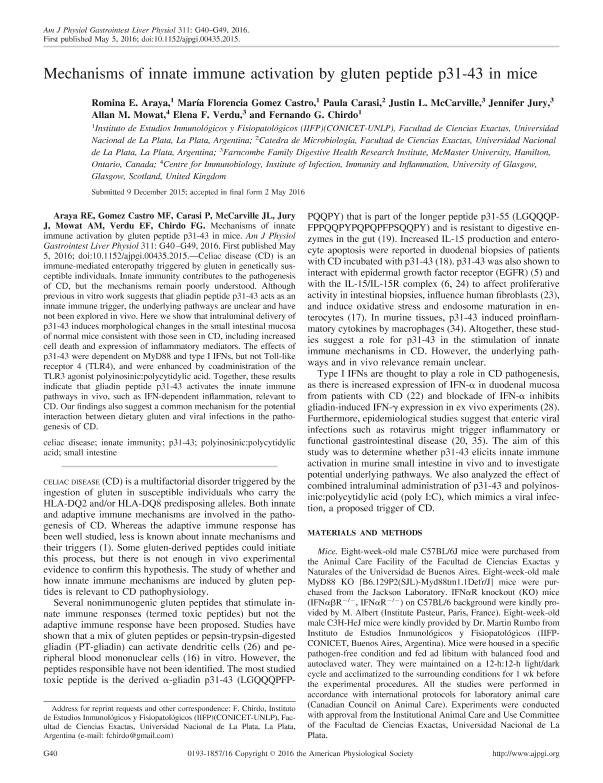Artículo
Mechanisms of innate immune activation by gluten peptide p31-43 in mice
Araya, Romina Elizabeth ; Gomez Castro, Maria Florencia
; Gomez Castro, Maria Florencia ; Carasi, Paula
; Carasi, Paula ; McCarville, Justin L.; Jury, Jennifer; Mowat, Allan M.; Verdu, Elena F.; Chirdo, Fernando Gabriel
; McCarville, Justin L.; Jury, Jennifer; Mowat, Allan M.; Verdu, Elena F.; Chirdo, Fernando Gabriel
 ; Gomez Castro, Maria Florencia
; Gomez Castro, Maria Florencia ; Carasi, Paula
; Carasi, Paula ; McCarville, Justin L.; Jury, Jennifer; Mowat, Allan M.; Verdu, Elena F.; Chirdo, Fernando Gabriel
; McCarville, Justin L.; Jury, Jennifer; Mowat, Allan M.; Verdu, Elena F.; Chirdo, Fernando Gabriel
Fecha de publicación:
07/2016
Editorial:
American Physiological Society
Revista:
American Journal of Physiology-gastrointestinal and Liver Physiology
ISSN:
0193-1857
Idioma:
Inglés
Tipo de recurso:
Artículo publicado
Clasificación temática:
Resumen
Celiac disease (CD) is an immune-mediated enteropathy triggered by gluten in genetically susceptible individuals. Innate immunity contributes to the pathogenesis of CD, but the mechanisms remain poorly understood. Although previous in vitro work suggests that gliadin peptide p31-43 acts as an innate immune trigger, the underlying pathways are unclear and have not been explored in vivo. Here we show that intraluminal delivery of p31-43 induces morphological changes in the small intestinal mucosa of normal mice consistent with those seen in CD, including increased cell death and expression of inflammatory mediators. The effects of p31-43 were dependent on MyD88 and type I IFNs, but not Toll-like receptor 4 (TLR4), and were enhanced by coadministration of the TLR3 agonist polyinosinic:polycytidylic acid. Together, these results indicate that gliadin peptide p31-43 activates the innate immune pathways in vivo, such as IFN-dependent inflammation, relevant to CD. Our findings also suggest a common mechanism for the potential interaction between dietary gluten and viral infections in the pathogenesis of CD.
Archivos asociados
Licencia
Identificadores
Colecciones
Articulos(CCT - LA PLATA)
Articulos de CTRO.CIENTIFICO TECNOL.CONICET - LA PLATA
Articulos de CTRO.CIENTIFICO TECNOL.CONICET - LA PLATA
Citación
Araya, Romina Elizabeth; Gomez Castro, Maria Florencia; Carasi, Paula; McCarville, Justin L.; Jury, Jennifer; et al.; Mechanisms of innate immune activation by gluten peptide p31-43 in mice; American Physiological Society; American Journal of Physiology-gastrointestinal and Liver Physiology; 311; 1; 7-2016; G40-G49
Compartir
Altmétricas



